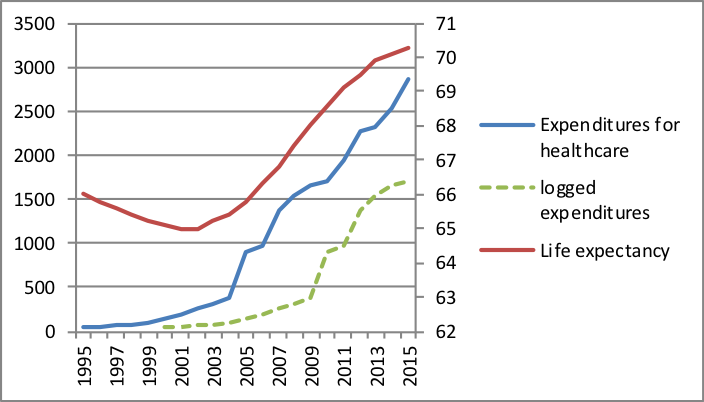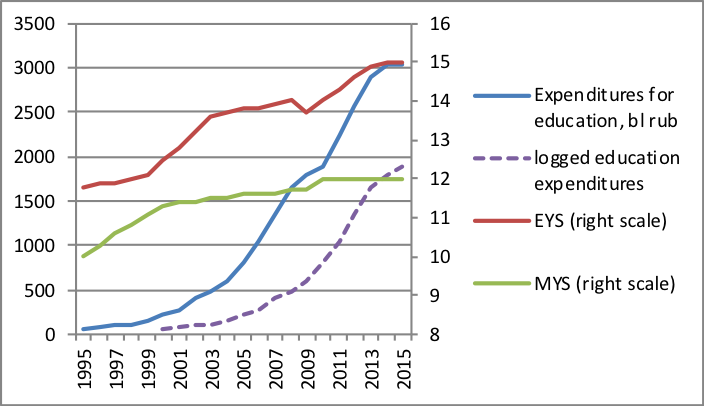Abstract
In the time of the post-industrial economy, human capital becomes more and more important in a country`s economy. The results of different studies identify human capital as an important determinant of regional development (
Keywords: Human capitalHuman Development Index (HDI)budgeteducationhealthcarestatistical analysis
Introduction
The 21st century is an era of innovations and technologies. A few decades ago resources and money played a great role in the economy. Nowadays, the professionals, who are able to create new things, influence the economic development. There are new trends in the international trade, too. Today, high - quality goods influence the international exchange. A country should have well-educated specialists to create such goods. It means that the education system affects the economy a lot and the government should pay much attention to its development. Although a good education is necessary for the development of the economy, it is not enough for its success. Human capital and economic growth have feedback effects in the long term and no effect in the short term (Banoa, Zhaoab, & Ahmada, 2018). Many researchers develop growth models with human capital accumulation and consider several fiscal instruments to finance the increase in government spending: transfers to households, output, capital and labor taxes Dissou, Didic, & Yakautsava, 2016).
Obviously, our country should have a good living standard for highly-qualified specialists to be satisfied with their life here. This includes such issues as social stability, a high level of healthcare and income, accessibility of education. We can not evaluate all these factors directly in numbers, except the income. Different social indexes should help us to do this. The most generalizing index (as it was mentioned before) is the human development index (HDI). The HDI is a complex statistic calculated every year to compare human welfare in different countries all over the world.
The HDI consists of 3 indexes that represent different aspects of humans` life (About human development, 2016). The first index is life expectancy at birth - that shows the quality of healthcare in the country because it is healthcare that affects peoples` life expectancy. The second index is an education index calculated by the mean year of schooling and the expected years of schooling; all these indexes show the quality of education, its availability and popularity. The last index is the gross domestic product per capita that shows us the wealth of the country. Thus, using the HDI we can evaluate many social processes. The HDI summarizes other indexes of human well-being. That`s why it is important to review this index to understand the current economic and social situation in the country. We used this index in our research to show the situation in Russia and compare it with that in other countries.
Problem Statement
Russia is the largest country in the world. Moreover, it has the richest reserves of mineral resources such as oil, gas, metals. Russia is on the 9th place in the countries’ population rating and on the 23rd place of the budget size rating. In other words, the country has excellent quantity indexes. But, when it comes to indexes showing quality and efficiency of resources usage, the figures are not very good. Let us characterize the HDI. Russia is on the 49th place, according to the HDI rank. It is at the bottom of the countries list with high HDI. In the Table
The table shows that, on the one hand, the Russian government expenditures exceed the Norwegian ones by 19%. But, on the other hand, the Russian HDI is 20% lower than the Norwegian one. The situation is the same with the components of the HDI, which are presented in table
As you can see, two of the three indexes have a gap of 20%. This situation raises the issue of the efficiency of the budget resources allocation. The share of the high-skilled goods export can be another indicator of economic situation. It shows the country`s dependence on high-skilled goods exported and the ability to produce this goods in the country. Table
Thus, having the richest reserves of mineral resources and huge opportunities for economic growth, Russia is lagging behind the other countries with the same or bigger budget size (Gumenyuk, 2017; Winters, 2011). This leads to the issue of right allocation and efficiency of resources usage.
Research Questions
In the conducted research, we studied a few interdependent indicators. Taking into consideration the fact that the free healthcare and the universal school education are guaranteed in Russia (Constitution of Russian Federation), we can say that the expenditures on these sectors are covered by the budget money. So, the quality of services in these sectors can indicate the quality of the government`s expenditures. In their turn, these expenditures appear to affect the relevant indexes of the HDI. In order to analyse the relation between the indexes, we studied the federal and subjects` budgets. Another question we tried to answer in this research is whether the HDI can affect the high-skilled export, which is the most important part of the international trade.
Purpose of the Study
The purpose of this study is to find out how the government expenditures affect different parts of the HDI and if there is an interdependence between the HDI and the high-skilled export.
Research Methods
In order to understand the interdependence between the reviewed variables, we chose and analysed the period from 1995 to 2015. Our choice is conditioned by the availability of the data. We analysed the following variables: the government expenditures on the education, the government expenditures on the healthcare, the shares of these expenditures in the consolidated budget, the life expectancy, the mean years of schooling, the expected years of schooling, the volume of high-skilled goods in the export. To understand whether these variables have any connections, we built the correlation matrix. You can see the results in table
According to the analysis, there is a high correlation between the direct expenditures on the education and the healthcare and the relevant parts of the HDI. As for the high-skilled export, there is a high correlation index between it and the expenditures on the education. Moreover, the correlation indexes show the interdependence between the high-skilled export and the components of the HDI. This interdependence proves the assumption that the life quality affects the economic indicators. There are low correlation indexes for the shares of the government expenditures. It can be explained in the following way: despite of the budget size changing, the share of the social expenditures remains approximately constant (look at table
To provide a wider picture of variables` interdependence, we conducted the regression analysis for several pairs of these variables. This analysis was conducted by the Ordinary Least Squares.
The first pair to analyse is the life expectancy and the government expenditures on the healthcare. We take a log of 5 years for this model. During the research, we came to the conclusion that the government expenditures do not affect the economy during the time of their usage. To allow these expenditures to affect the healthcare system, some time must pass. And after that, even more time must pass for the relevant indexes to be changed. That is why the log was used in this model. In Figure

In order to provide a more accurate analysis, we used the mathematical interpretation, which is given in table
In this model we can see that the R-squared exceeds 0.8; it means that the model is statistically acceptable. The significance of the variable is determinate according to P-value: if this index is less than 0.001, the variable is very significant. The data given in this model prove that the government expenditures on the healthcare strongly affect the life expectancy.
The second model was created to find the interdependence between the components of the education index and the government expenditures on the education. In Figure

This mathematical model is presented in table
The final model is created to check the assumption about the influence of the HDI expenditures on the high-skilled export.
Findings
The reviewed models show the following results:
Being a part of the HDI, the life expectancy is heavily affected by the government expenditures on the healthcare.
Being a part of the HDI, the expected years of schooling and the mean years of schooling are heavily affected by the government expenditures on the education.
The relations between the HDI and the high-skilled export can not be described by using only measurable variables because there are lots of immeasurable factors that affect the international trade.
Conclusion
To sum up, the reviewed models show us that the government expenditures affect the relevant parts of the HDI. This means that the vectors of the government expenditures influence both human wellbeing and the HDI. Moreover, the expenditures on education affect the volume of the high-skilled export, which is a very important part of the economy. Thus, allocating budget resources, the government should take into consideration the education and the healthcare. Only under such conditions the intensive and high-skilled development of our economy is possible.
Acknowledgments
This research did not receive any specific grant from funding agencies in the public, commercial, or not-for-profit sectors.
References
- Banoa, S., Zhaoab, Y., & Ahmada, A. (2018). Identifying the impacts of human capital on carbon emissions in Pakistan. Journal of Cleaner Production, 183, 1082-1092
- Dissou, Y., Didic, S., & Yakautsava, T. (2016). Government spending on education, human capital accumulation, and growth. Economic Modelling, 58, 9-21.
- Gumenyuk, E. (2017). Index of human potential development as an instrument for assessing of the level of social development of Baltic region countries// Baltic region. № 3. P. 63-81.
- Winters, J. (2011). Human capital, higher education institutions, and quality of life. Regional Science and Urban Economics, 41, 446-454.
- Flückigera, M., & Ludwigb, M. (2018). Geography, human capital and urbanization: A regional analysis. Economics Letters, 168, 10-14
Copyright information

This work is licensed under a Creative Commons Attribution-NonCommercial-NoDerivatives 4.0 International License.
About this article
Publication Date
17 December 2018
Article Doi
eBook ISBN
978-1-80296-049-5
Publisher
Future Academy
Volume
50
Print ISBN (optional)
-
Edition Number
1st Edition
Pages
1-1464
Subjects
Social sciences, modern society,innovation, social science and technology, organizational behaviour, organizational theory
Cite this article as:
Andrianov, K., Lazareva, O., & Krasnova, L. (2018). Human Capital And Its Components Statistical Analysis Of Budget In Russia. In I. B. Ardashkin, B. Vladimir Iosifovich, & N. V. Martyushev (Eds.), Research Paradigms Transformation in Social Sciences, vol 50. European Proceedings of Social and Behavioural Sciences (pp. 1457-1464). Future Academy. https://doi.org/10.15405/epsbs.2018.12.178

